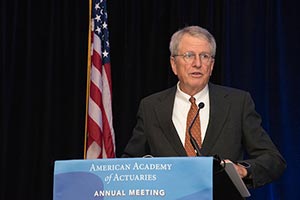Teamsters Could be Left in Quandary If Agency that Ensures Retiree Benefits Goes Insolvent

WASHINGTON — The Pension Benefit Guaranty Corp. could go insolvent within a decade, and the agency’s director doesn’t believe that Congress will fix the problem anytime soon, putting Central States Pension Fund retirees at risk of receiving zero benefits if it went bankrupt, too.
The government agency ensures retirees receive benefits if their pension fund becomes insolvent, similar to how the Federal Deposit Insurance Corp. protects bank accounts. But W. Thomas Reeder, director of the Pension Benefit Guaranty Corp., said that without congressional action there won’t be stopgap left for the 10 million Americans in more than 1,400 multiemployer pension plans.
RELATED: Central states woes continue, pension value falls $500 million
“People outside of Washington think 10 years is short period of time. Inside Washington, 10 years is a geologic era. Congress is constantly dealing with tomorrow or this evening, and when you tell them they have 10 years to fix a problem, it’s like telling them they have a longer vacation,” Reeder told the American Academy of Actuaries on Nov. 4.
“When the Central States Pension Fund tried to reduce benefits to an amount higher than the PBGC-guaranteed level, many congressmen, senators and participants had a big problem with it. So if the PBGC becomes insolvent, it’s going to be a lot worse,” he added.
Congress could give PBGC the authority to set its own premiums, but Reeder acknowledged that probably won’t happen. In June, the agency wrote that aggregate premiums would need to be six times higher the current level to keep the backup fund afloat for the next 20 years.
“Most insurance companies set their own premiums,” Reeder said. “It’s unfortunate that the administration has to ask for premium increases that look like a tax increase. Many employers view premiums as taxes and congressmen have a hard time voting for increased premiums for that reason.”
Ted Goldman, senior pension fellow at the American Academy of Actuaries, said that finding the right level to set premiums is a delicate balancing act.
“If you raise them too high, you’ll chase some employers out of the system. It’s a very fragile system right now, because too much of one thing is going to cause something else to brake, but not enough isn’t going to solve the problem,” he said.
President Obama submitted a budget to Congress this year to generate $15 billion more in premiums over the next 10 years. It would have a variable premium increase that exempts troubled funds such as Central but applies to healthier pension programs. It also would include exit premiums for employers leaving a multiemployer pension plan to pay both a withdrawal fee to the fund and one to PBGC, according to Reeder.
“If the premiums get too high, then some employers will terminate their defined benefit plans and move to a defined contribution model. The piece that people tend to miss is that the better-funded plans are most at risk because there are no withdrawal liabilities to keep them in the system,” said Randy DeFrehn, executive director of the National Coordinating Committee for Multiemployer Plans.
Reeder told the audience that the solution will be painful and not only consist of premium increases, but also possible benefit cuts and higher contributions by employers. Currently, a 30-year career employee entitled to a $26,000 annual benefit would earn $12,870 per year when the pension enters the PBGC system, but without action, the agency said it would drop to $2,000 and eventually zero.




